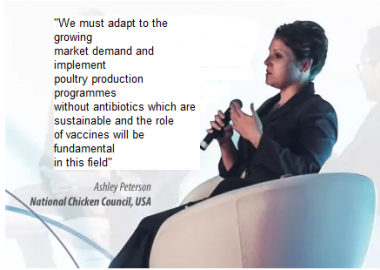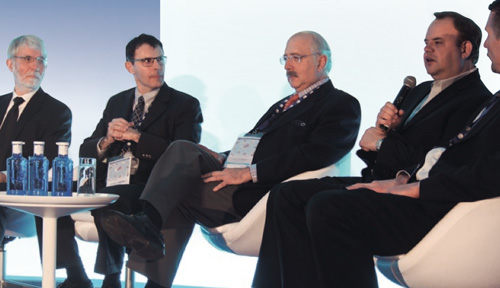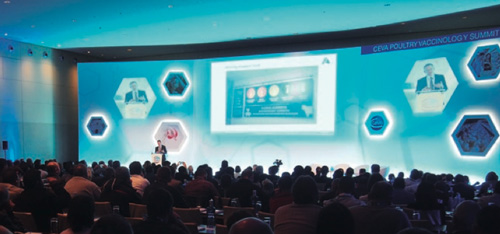
RECOMMENDED

In line with the two previous avian vaccination summits hosted by CEVA in 2010 and 2013, the event which took place in Barcelona -with 480 participants, from 49 different nationalities-was the ideal platform to exchange visions and experiences about some key issues of present and future production of poultry.
Attendees to this summit have enjoyed a unique opportunity to share the most recent information on the new and noted global trend of an antibiotic-free poultry production, from the perspective of key companies and organizations worldwide; and they could also learn firsthand technological improvements of new vaccines, proposed as an essential tool to achieve this objective.
To help improve daily activity performance of avian production, CEVA has promoted direct communication of professionals providing them different worldwide perspectives and initiatives, also providing state-of-the-art scientific information for the practical application at field level.

480 participants from 49 different nationalities have attended this III Ceva Summit
esta III Cumbre de Ceva han asistido 480 participantes de 49 nacionalidades distintas
The new global trend of an antibiotic-free avian production, as well as learning about technological improvements of new vaccines proposed as an essential tool to achieve this objective have been the main topic of this summit
We estimate that in the year 2050, 70% of the global population will be concentrated in urban areas and this, together with the exponential population growth, will bring about an increase in the demand for food of 50% and an increase of more than double as regard the demand for animal protein.
This circumstance causes food production to become a priority for the industry. Also, we must add to this scenario the increasingly important role that quality and food safety is acquiring for the consumer.
It follows that the market will demand greater food production and better quality, so we must strengthen a healthy bond between animals and humans.
To all this we must add the new approach in food production conditioned by the new global trend on the production of animal food free of antibiotics, which becomes the great challenge faced by the food industry and emphasizes the important role that vaccination will play as a fundamental and vital tool in this new framework.

In this sense, Ashley Peterson, member of the National Chicken Council of USA, highlighted the growing demand from the North American market for poultry produced without the use of antibiotics
The pressures of the American consumer, together with the political pressures and of the regulatory agencies, entail a significant adaptation by the North American producer sector to adapt and to solve the growing demand of the market of poultry products that have not been exposed to the use of antibiotics.
The use of antibiotics in poultry production is a matter of considerable concern to the consumer, which is also aggravated by misuse of labeling.
This topic was also widely debated by the speaker, since there are already many voices that are raised to indicate a clear differentiation between those “antibiotic-free” products from others that indicate that “antibiotics have never been used throughout their productive cycle”.

The elimination of the use of antibiotics in poultry production can lead to an increase in mortality and an increase in the rate of food conversion and waste generation. So sustainability is affected and this will have serious economic consequences
The emergence of antibiotic resistances and the impact of these resistances on the world population are some of the vectors that push us to seek a sustainable poultry production.
In this regard, Peterson, throughout his presentation, emphasized the importance of changing the mode of production and the vital role that vaccines will play to ensure profitability on farms.
The consumer is increasingly focused on the quality, traceability and mode of production of food that are part of his shopping cart and in this context, Michael Freedman (IGD, United Kingdom) emphasized the channel and mode of communication that we must use to eliminate false myths and build trust when buying poultry products.
Consumers' expectations have been redefined, with a new segmentation of them. We must provide information to the consumer, providing it in a positive way and based on opinions from reliable sources.
Concern for the generation of antibiotic resistance and the impact on their effectiveness is an issue that is a headache for the consumer.
To support this new global trend of a production of antibiotic-free poultry from the perspective of companies, Rick Sharpton of Perdue Farms (USA) revealed his company's experience in dispensing with the use of antibiotic drugs in production.
This mentality change when producing antibiotic-free foods is already reflected in large poultry companies that, being aware of these transition moments, point in another direction, addressing the challenge based on what their customers demand.
In this sense, the use of vaccines for both speakers is the tool to be taken into account to resolve the effects of the elimination of antibiotics.
Throughout the day, the demand from the consumer and therefore from the society of antibiotic-free poultry products was emphasized, but can this elimination or restriction of the use of antimicrobials go against animal welfare?
To try to answer this question, Maarten de Gussem (Vetworks, BE) presented in his presentation the different moral conditions in relation to the use of antibiotics and their relationship with the welfare of birds.
He also highlighted the role of vaccines as a method of controlling different diseases in this new framework and as a mechanism that ensures that the animal welfare of birds is not compromised.
Faced with this new evolution of consumer demand in terms of antibiotic-free and sustainable production, the response of the poultry industry focuses on how to be part of the solution, based on the use of new vaccines that produce less viral excretion, while ensuring protection against the pathogen.
In this way, Yannick Gardin (CEVA) opened the second part of the “III Ceva Summit of Avian Vaccination” highlighting the role that the pharmaceutical industry should play in this new scenario.

He also pointed out the importance of the development of new vaccines, supported by better epidemiological knowledge and studies of infection mechanisms, as tools to achieve these new objectives.
Vaccination processes should be improved to induce protection, increasing the resistance of chickens to pathogens and reduce the spread and dissemination of outbreaks. On the other hand, he also highlighted the importance of updating regulations when obtaining licenses for the use of vaccines, since bureaucratic obstacles in most cases oblige us to use vaccines that are already part of the past in response to outbreaks.
Pathogens vary and vaccines must adapt to this rate of change.
Fundamentally, through vaccination we seek several objectives, such as protecting from diseases, preventing economic and production losses derived from them, guaranteeing animal welfare and reducing, as far as possible, the use of antibiotics in food production.

Dr. Jan Arend Stegeman (University of Utrecht-Netherlands) in his presentation pointed out the critical importance of homogeneity and the reduction of viral excretion to establish the effectiveness of vaccines from an epidemiological perspective.
When there is an outbreak of disease, the existence of vaccinated animals reduces the potential for infection and spread of the pathogen, so the effect on infection depends on the effectiveness and coverage of that vaccine.
Hence, in epidemiology, the role of vaccines as disease control mechanisms is also highlighted.
Vaccination influences the rate of reproduction and infection, thus helping to stop the disease.
Through an example of vaccination in humans, the speaker masterfully transferred the concept based on the fact that a higher proportion of the vaccinated population prevents the spread of the virus to those individuals who are not vaccinated.
He also presented several studies where the effect of vaccination on the modification of the transmission of Newcastle disease was observed. The heterogeneity of the population has an effect on infection but, through several epidemiological equations, he was able to point out the effects of vaccination on the immunity of the group, largely preventing the spread of the disease.
The birds are weighing more and more and spend more time in the sheds, increasing the time and the probability of coming into contact with the pathogens, so the new vaccine protection should be longer and even extra protection should be provided. With this in mind and based on an increase in the density of the sheds and the increased risk of infection, the presentation of the American speaker Nick Dorko (Aviagen) took place.
On the other hand, Marcelo Paniago (CEVA-France) presented the different results of the new technological vaccines and their effects on viral excretion. According to the studies exposed, vector vaccines reduce viral excretion rates. This more than remarkable decrease represents a huge progress in the industry.
With the new vector vaccines, the wastewater excretion of the virus is reduced, while maintaining the same degree of systemic immunity, so they become the tool of the future for disease control.
As we know, Gumboro disease has very negative effects on the poultry economy and at this Ceva summit, once again, field experiences were presented in the control of the disease.
On this occasion, José Luis Valls presented the work carried out by CEVA's veterinary services in Spain, which has monitored all the batches where immunocomplex vaccines have been applied in the incubator

« Laboratory tests and field results demonstrate the advantages of vaccination with immunocomplexes in the incubator over vaccination in drinking water in Gumboro disease, as well as the rapid return on investment» José Luis Valls Spain

The tools used for this purpose have been serology (by ELISA), histopathology and RT-PCR
According to the study presented by the speaker Valls, laboratory tests and field results have demonstrated the advantages it provides at an epidemiological level, such as the return on investment obtained compared to the use of IBD vaccines in drinking water.
Subsequently, the speaker Mario Sergio Assayag (JBS, Brazil) presented to the attendees the field experience in Brazil about the use of vaccines for the prevention of Newcastle disease.
The Brazilian poultry industry is free from velogenic Newcastle disease, but vaccination of birds with live vaccines causes significant economic losses induced by the circulation of vaccine viruses on farms and consequent clinical effects of post-vaccine reactions. And this explains the intense search by the sector of all the instruments that allow us to reduce the impact of these reactions.
According to the data provided by Assayag, the set of biosecurity measures adopted to improve the conditions on the farms together with the use of vectored vaccines has allowed the clinical signs and performance losses caused by the circulation of vaccine viruses of ND to be significantly reduced, as a significant reduction in the use of antibiotics on Brazilian farms in a year of experience.
"The measures adopted to improve the conditions of Brazilian farms together with the use of vaccines have allowed us to improve all rates against Newcastle disease" Mario Sergio Assayag JBS, Brazil
The reduction of excretion and spread of viruses is vital, as is the study of the possible effects of vaccines and vaccination. Vaccination against this disease will increase resistance and reduce infection between birds and different geographical areas, so the vaccination program should be able to increase group immunity.
Infectious bronchitis was another pathology discussed in the CEVA summit, so Sjaak de Wit (GD, The Netherlands) talked about the ways of transmission of the disease and the importance of knowledge thereof to exercise greater control of the disease
The speaker presented several studies showing the rate of infection of the virus and its high spread, as well as the role of vaccination to decrease the transmission parameter.
In the case of infectious bronchitis and according to the data offered by Sjaak de Wit: "There are 28 infections for each infected bird, so there is a very rapid horizontal spread of the disease, and this is where the role of vaccines can be fundamental for disease control, »since the transmission rate is affected"
If we want to reduce or eliminate the use of antibiotics from poultry productions, we must improve the quality of biosafety, use and vaccination management. In relation to the latter, Yannick Gardin (CEVA) made a presentation on the fundamentals, advantages and role that in ovo vaccination plays and will play for the poultry industry.
Throughout his interesting presentation, he presented to the attendees a machine for the application of in ovo vaccination and showed different scientific studies that support the operation of the same, since when the in ovo vaccination technique is well applied, no significant differences are observed compared to other forms of vaccine application.
Vaccinating eggs and not chickens provides innumerable advantages, but for this it is important to know the factors and stages of evolution of the embryo within the egg. Therefore, Yannick Gardin illustrated the attendees about the correct mode of application of the vaccine and the appropriate embryonic stage for its use.
At the end of the III Summit of avian vaccination, a great discussion forum took place, where attendees had the opportunity to talk with the main speakers, share experiences and enrich the common understanding.
Subscribe now to the poultry technical magazine